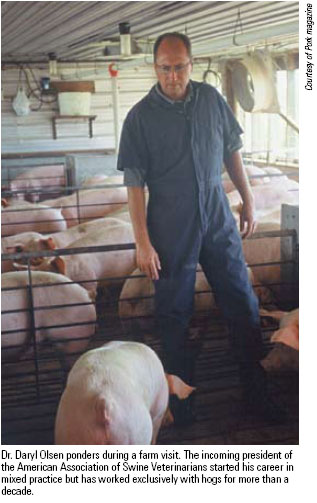AASV can go from good to great, president says
 Dr. Daryl Olsen is plotting a steady course for his year as the head of the American Association of Swine Veterinarians.
Dr. Daryl Olsen is plotting a steady course for his year as the head of the American Association of Swine Veterinarians.
The incoming president brings a sense of continuity to the office, with plans to advance current AASV initiatives while conferring with past and future leaders.
The president
Growing up on a farm in South Dakota, Dr. Olsen knew he wanted to be a mixed animal practitioner—primarily working with large animals.
He graduated from Iowa State University College of Veterinary Medicine in 1982 and soon joined the Audubon-Manning Veterinary Clinic in Audubon, Iowa. He started in mixed animal practice, but he began focusing exclusively on swine in 1991.
Early in his career, Dr. Olsen became an active member of the AASV.
"I thought the organization provided probably one of the best annual meetings and provided information that really was important to me in practice," he said.
Dr. Olsen was active with the Pharmaceutical Issues Committee before other AASV members asked him to run for vice president.
After he succeeded to the position of president-elect, Dr. Olsen based the theme for the 2007 meeting on the book "Good to Great" by Jim Collins.
"As veterinarians, we always rely on research and on data," he said. "When I first read this book, years ago, I was so impressed that this was intensive, extensive research done by this group on what it took to take a company from good to great over a long period of time."
Dr. Olsen said the AASV can similarly progress from good to great.
The 2007 meeting also included a general session on porcine circovirus diseases and seminars on porcine reproductive and respiratory syndrome. Dr. Olsen wants to keep moving forward with the AASV initiative to eradicate PRRS from North America—which was the long-term goal of outgoing president Dr. Scott Dee.
Dr. Olsen said the association must strive to support and serve the growing international membership, too. The AASV already translates some of the materials on its Web site into Spanish.
In the United States, the association must attract the best and brightest students in response to the country's shortage of food animal veterinarians. Dr. Olsen said the AASV recently added two students to the board of directors as nonvoting members.
Dr. Olsen said midcareer swine veterinarians need to re-evaluate professionalism and ethics as their roles change. Challenges range from the emergence of large corporations in the swine industry to the rise of consumer concerns about animal welfare.
"We always have to be open to consumer needs and consumer wishes without being driven by activist demands," Dr. Olsen added. "We have to remember that activists' goals are not always what's best for the animal, but what in turn will make it most difficult for the industry to survive."
Other officers
Joining Dr. Olsen as AASV officers are the president-elect, Dr. Kerry Keffaber, North Manchester, Ind.; vice president, Dr. Rodney Baker, Ames, Iowa; and immediate past president, Dr. Scott Dee, Alexandria, Minn.
Dr. Dee spoke during the AASV business breakfast about the progress of the North American PRRS Eradication Task Force. He said leaders, scientists, team builders, and educators are important to the success of the long-term project.
Dr. Roger Mahr, AVMA president, also spoke at the business breakfast.
"The AASV is a vital and very strong organization," he said. "I also want to say how important the past and present support of AASV members is to the profession and particularly to the many issues that the AVMA focuses on."
Dr. Mahr outlined the AVMA's five key issues of animal welfare, economic viability, veterinary education, veterinary workforce, and veterinary services. He also discussed some of the global and interdisciplinary aspects of veterinary medicine.